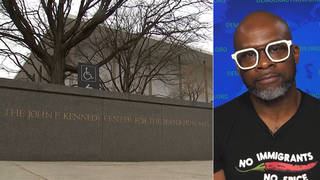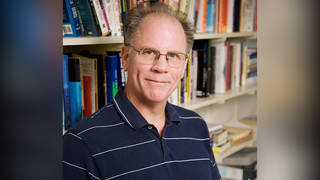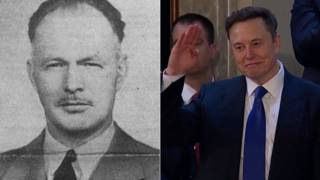
The mid-term elections are one week away–will your vote be counted? A new HBO documentary exposes the vulnerability of electronic voting machines. The film follows investigative journalist Bev Harris as she investigates the security and accuracy of electronic voting systems. Harris joins in our firehouse studio. [includes rush transcript]
There is a week to go before millions of voters cast their vote in the mid- term elections. Many are calling this the most high-stakes election in recent years with the possibility of a Democratic takeover of Congress. But since the contested Presidential elections of 2000 and 2004, more people have been raising concern about the integrity of our voting system. Today, we spend the hour looking at the state of voting in this country.
We start by looking at electronic voting machines. There have been widespread reports of malfunctions and security lapses even though these machines count 80 percent of the votes cast in America today. Last month, Maryland Governor Robert Ehrlich called for the state to scrap its electronic voting system and revert to paper ballots in the upcoming election. He cited technical glitches that occurred during the state’s primary election. In that election, electronic voting machines that were built by the Diebold corporation, repeatedly crashed. Ehrlich said that the voting situation is “approaching crisis proportions.” But the problem is not limited to Maryland–a report released earlier this year by the group Common Cause found that Maryland was only one of 17 states nationwide whose voting system is at “high risk” for a compromised election.
Well a new documentary airing on HBO on November 2nd exposes the vulnerability of computers that are counting our votes. The film follows Bev Harris, a Seattle grandmother and writer as she investigates the security and accuracy of electronic voting systems. Her investigation takes her from the trash cans of Texas to the secretary of state of California, and finally to Florida. We’ll talk to Bev Harris in a moment — But first we go to an excerpt from the documentary, “Hacking Democracy.” This clip looks at a faulty vote tally from the two thousand Presidential election in Volusia County, Florida.
- Hacking Democracy–excerpt of documentary premiering on HBO on November 2nd.
- Bev Harris, publicist turned investigative reporter. She is author of the book “Black Box Voting.” More information at BlackBoxVoting.org
Transcript
AMY GOODMAN: Well, a new documentary airing on HBO on November 2nd exposes the vulnerability of computers that are counting our votes. The film follows Bev Harris, a Seattle grandmother and writer, as she investigates the security and accuracy of electronic voting systems. Her investigation takes her from the trash cans of Texas to the Secretary of State of California, and finally to Florida.
We’ll talk to Bev Harris in a minute, but first we go to an excerpt of the documentary, Hacking Democracy. This clip looks at a faulty vote tally from the 2000 Presidential election in Volusia County, Florida.
NARRATOR: As dusk fell on election night, one official noticed something very strange: a sign that the heart of America’s democracy was in danger. In Volusia County, Florida, an election computer counted Al Gore’s totals backwards. He had negative votes.
DEANIE LOWE: It was showing a minus sign in front of the votes that it had subtracted from Gore. I mean, it wasn’t like it was trying to hide it. It says there’s minus-16,022 votes here.
NARRATOR: How could a computer that is supposed to protect the votes of you and me count backwards to give a candidate negative votes? Either it was an error or someone had tried to rig the election.
AMY GOODMAN: Hacking Democracy will air on HBO on November 2. Bev Harris joins us now in New York, author of Black Box Voting. Welcome to Democracy Now!.
BEV HARRIS: It’s nice to be here.
AMY GOODMAN: So, how did that happen in Volusia County, Florida?
BEV HARRIS: Actually, according to internal memos, it was a replacement ballot box. A ballot box nowadays is the size of a credit card. It’s electronic, but they replaced it, and the offending ballot box is now missing.
AMY GOODMAN: How did you get interested in this whole issue?
BEV HARRIS: Well, you know, I had read that the voting machines were using secret proprietary software, and so I wanted to find out who owned the companies, and as I looked into that, I discovered a Republican senator from Nebraska who was running for office had ownership in the company that was counting his own votes. That’s Chuck Hagel. I couldn’t go to sleep that night. I never intended to get into this, but, you know, one question leads to the next, and in this situation every answer is the wrong answer.
AMY GOODMAN: And so, as you’ve conducted this investigation, how long has it been now, when you couldn’t sleep that night?
BEV HARRIS: Four years.
AMY GOODMAN: What have you found about the electronic voting machines of this country? HBO, in this documentary that they’re going to be airing November 2nd, just followed you around?
BEV HARRIS: Mm-hmm. Yeah, they followed me around for — well, it wasn’t HBO, it was two British gentlemen, Simon Ardizzone and Russell Michaels, and after about three years they caught all kind of interesting things on camera that is really quite amazing, which is why we’re recommending citizens go out with video cameras this November. But we found that not only are the machines error-prone, they’re also tamper-friendly, and that the companies that make them are in cover-up mode.
AMY GOODMAN: Tamper-friendly?
BEV HARRIS: Yes. They seem to be built for tampering. I can tamper with it; how sad is that? I’m not a computer scientist.
AMY GOODMAN: How can you tamper with it?
BEV HARRIS: Well, they actually have multiple points where you can go in and insert something or alter something. And interestingly, there’s been many studies now, both from ordinary citizens and from computer scientists and universities. All of them have been able to penetrate the systems and manipulate elections, and all of them use different attack points. So, you know, when you have a complicated system, there’s a lot of failure points, and there’s a lot of attack points. It’s not just one.
AMY GOODMAN: Talk about election protection, what you just said: well, you can just go out with a video camera. What exactly do you mean?
BEV HARRIS: Well, one of the things we found in 2004 is that terrible things happen in elections, and if you come back and tell a story about it, it’s very difficult to enact change, it’s very difficult to get the media to cover it. However, if you get videotape of the problem — if we all remember Rodney King: if that beating had happened and there was no video, very little would have ever been said about that. We need to get the kind of documentary evidence — the citizenry needs to get it — to prove this case. And we need to get evidence in the form that it can’t be spun or explained away. And the two best kinds of evidence available to us are videotape and public records.
AMY GOODMAN: Well, what do you mean by videotape, because if you’re talking about electronic voting machines, then what’s the percentage now, what, three-quarters of votes are counted on electronic voting machines?
BEV HARRIS: Right, computerized voting machines, actually it’s up to almost 90% of the vote. And remember, computerized voting doesn’t have to be a touch screen. It can be any votes that go into a computer. People are surprised to know that even absentee votes, once they get to the elections office, goes straight into a computer. And it is at about 90% now.
AMY GOODMAN: So how do you film if a computer is hacked? I mean, it doesn’t help when you walk in with your little camera.
BEV HARRIS: Well, you can get a lot of things. For example you can — imagine in 2004, when they said that this election office was shut down due to Homeland Security reasons, which was bogus, if somebody had had a video camera, that would have been very helpful. We’re seeing situations every day now, where somebody, if they just had a video camera — there are, for example, error messages showing up on the central tabulator, that are really scary, saying things like “I can’t connect to the network anymore,” you know, “I just lost my connection.”
And the public records, I can’t emphasize enough how important they are. In San Diego in the June 6 election, the event log, the audit log that was obtained by a citizen named Bruce Sims, shows the voting machine dialing out to Diebold at 9:31 p.m. during the count on election night. These are the kinds of things that show up.
AMY GOODMAN: Wait, explain that.
BEV HARRIS: Yes. It’s difficult to explain.
AMY GOODMAN: What do you mean, the machine dialing out?
BEV HARRIS: The machine dialed out and made a remote connection to Diebold at 9:31 p.m. during the count. And when you say, “Explain it,” I don’t know of any legitimate explanation.
AMY GOODMAN: So, what happened in that case?
BEV HARRIS: Interestingly enough, as we find citizens out there gathering these, public officials are in many cases — and San Diego is one — not following the law, not following the regulations. The first thing we have to do is find out if they even are following them — they aren’t there — and then we need to take action to enforce the law and get them taken out of office. It’s very difficult, because there’s very little will to enforce and there are very few consequences for election officials who fail to follow the law.
AMY GOODMAN: The significance of Governor Ehrlich saying no electronic voting machines in Maryland?
BEV HARRIS: Very interesting. And we are noticing — I know everybody wants to say this is Republicans against Democrats, and so forth, but we are noticing that in the states with touch screen voting where the Democrats are in control, it is the Republicans that are calling for paper. That’s the case in Georgia, in Maryland, and in my state, in Washington state.
AMY GOODMAN: We’re going to go to break, and when we come back we’ll be joined by Wendy Weiser of the Brennan Center for Justice, and we’ll go to Columbus, Ohio, and Harrisburg, Pennsylvania, for more election coverage.












Media Options